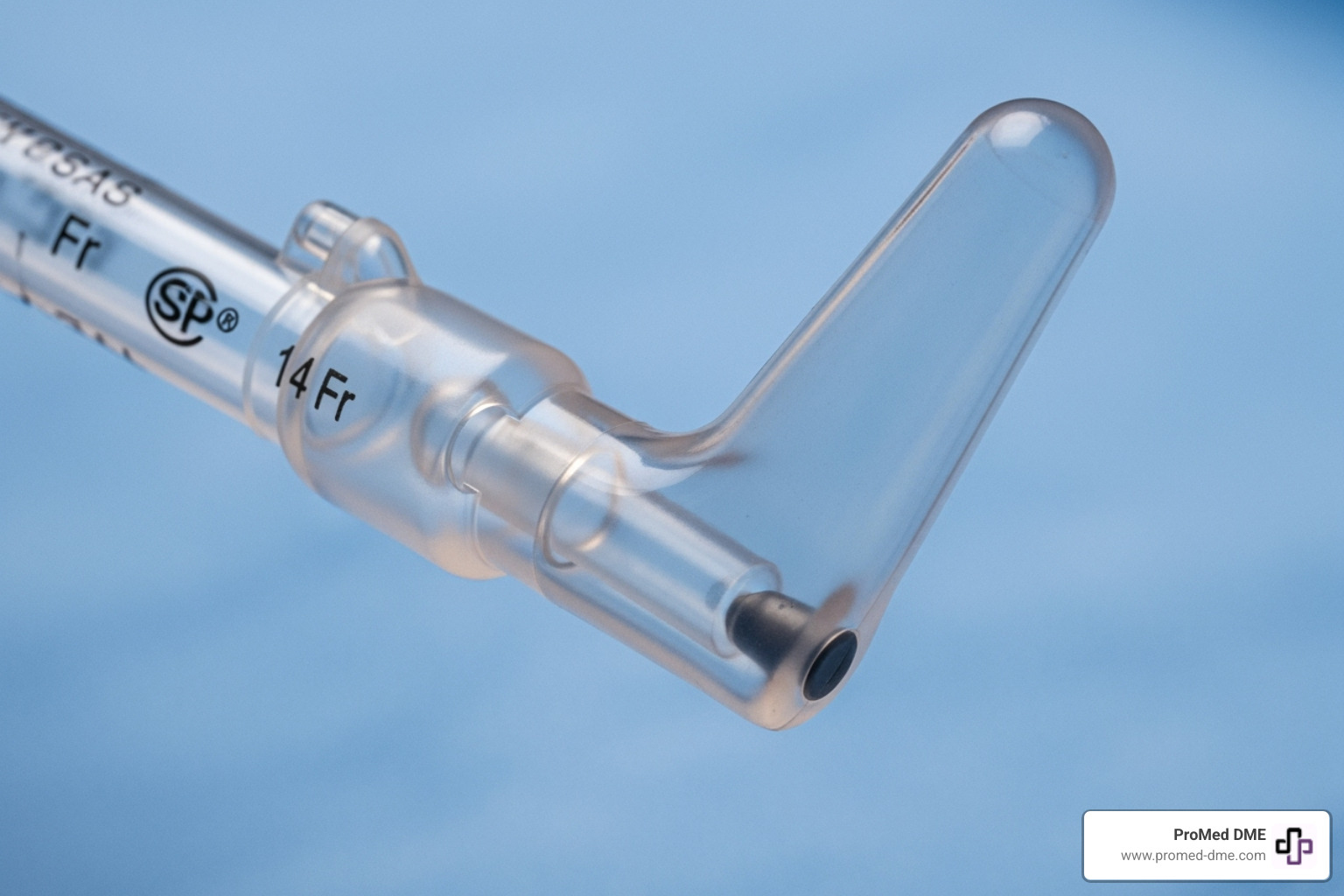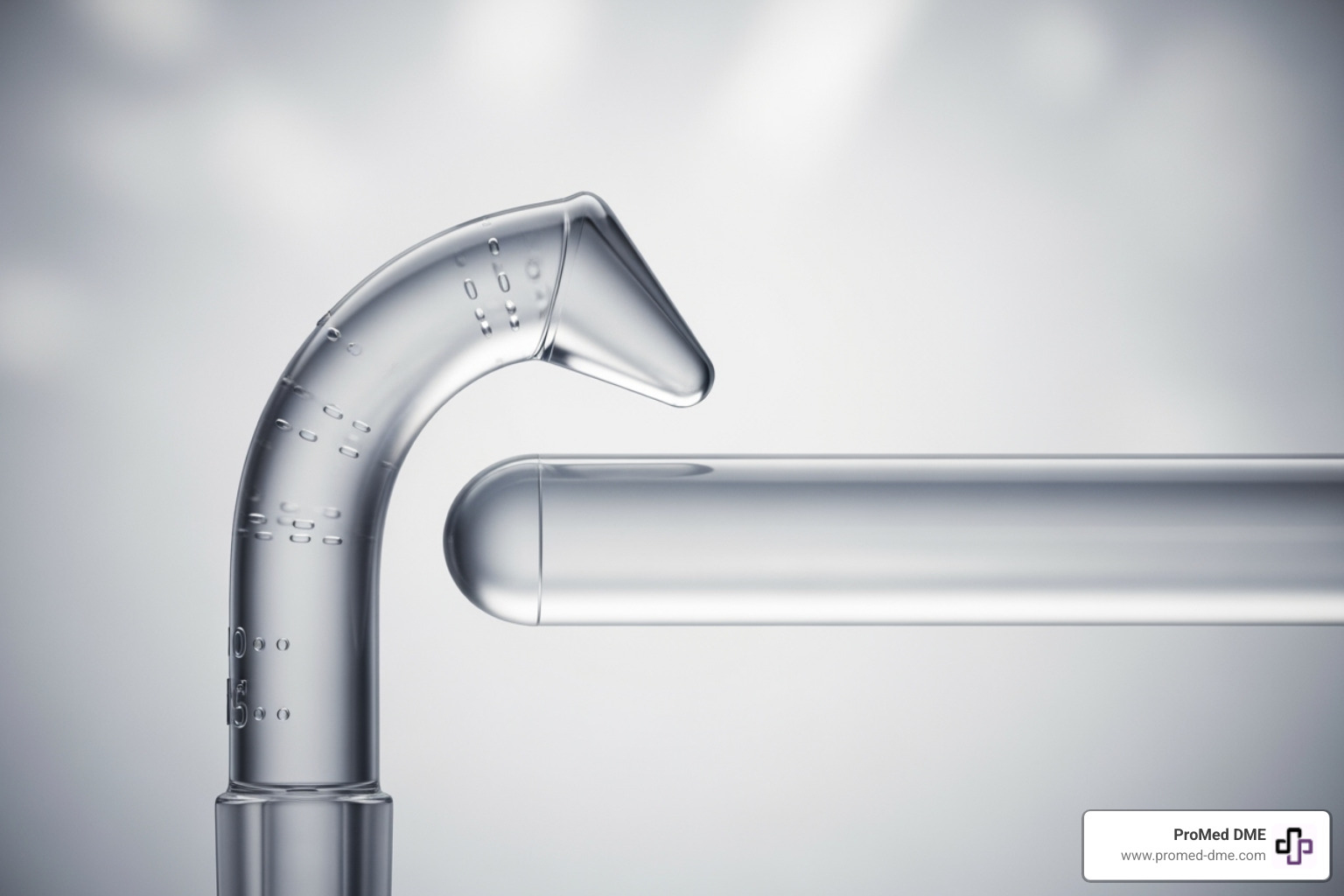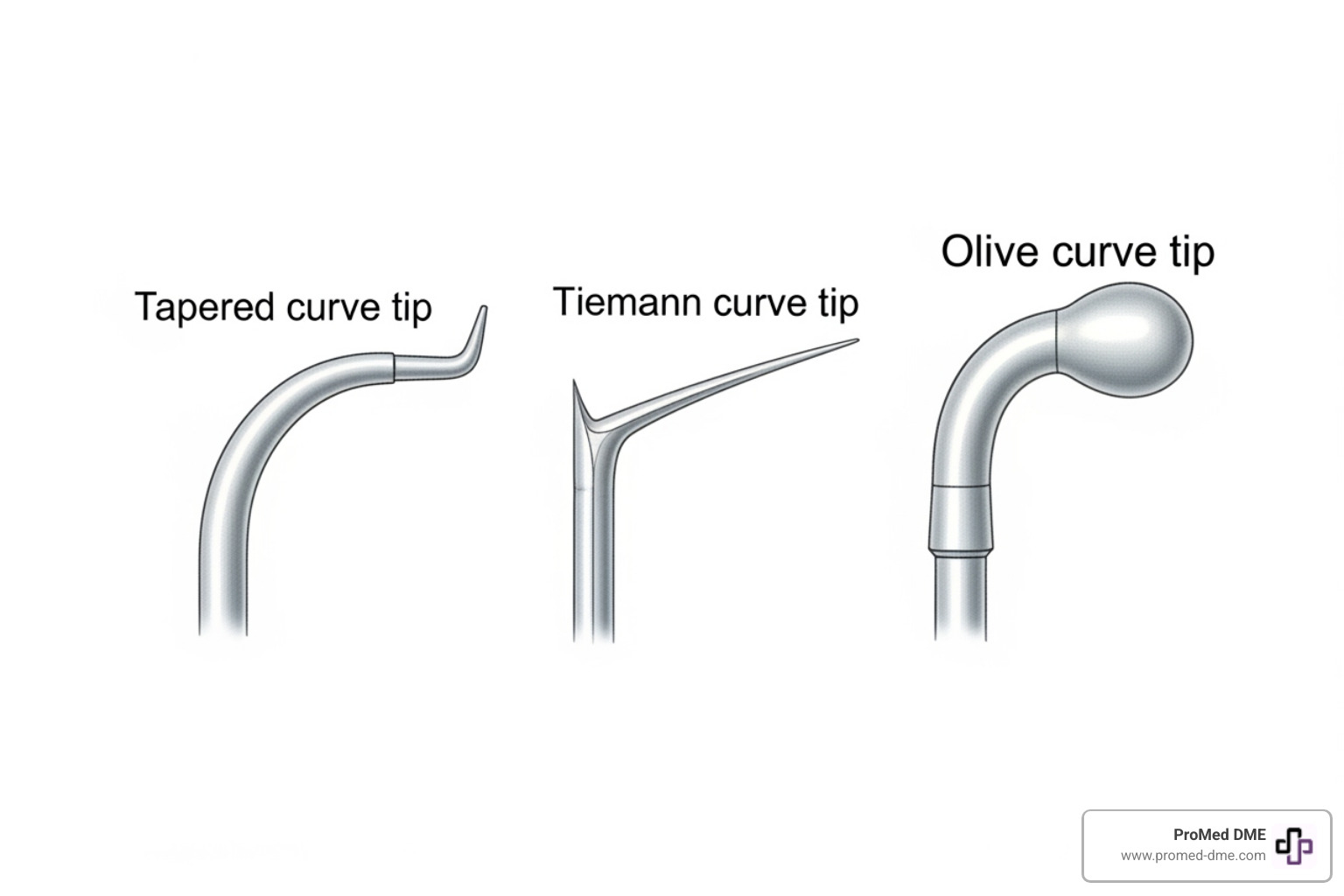Choosing Your Catheter: The Lowdown on Coudé, Disposable, Reusable, and Pre-Lubricated Options

Why Understanding Your Catheter Options Matters
Coudé tip catheters are specialized urinary catheters with a curved or bent tip. They are designed to steer past anatomical obstacles like an enlarged prostate, urethral strictures, or scar tissue that can make inserting standard straight-tip catheters difficult or painful.
Quick Answer: What You Need to Know About Coudé Tip Catheters
- What they are: Intermittent catheters with a curved tip (the French word "coudé" means "bend" or "elbow")
- Who needs them: Primarily individuals with Benign Prostatic Hyperplasia (BPH), urethral strictures, false passages, or post-surgical scarring
- Main types: Tapered tip (short, strong curve), Tiemann tip (longer, more flexible), and Olive tip (ball-shaped end)
- How to use: Insert with the curve pointing upward toward the ceiling or face
- Insurance: Covered by Medicare and most private plans when medically necessary (HCPCS code A4352)
- Frequency: Single-use only—dispose after each catheterization
If you struggle with painful or difficult catheterization using a standard straight catheter, a coudé tip catheter can make the process significantly easier and more comfortable. Its curved design helps the catheter glide past tight spots in the urethra by following the body's natural anatomy.
This reduces discomfort, lowers the risk of creating false passages, and provides a safer self-catheterization experience. Choosing the right catheter also involves considering features like pre-lubrication, closed systems, and materials. Your healthcare provider will determine if a coudé catheter is right for you based on your specific anatomy and medical needs.

A Deep Dive into Coudé Tip Catheters
The word "coudé" (pronounced "koo-DAY") is French for "bend" or "elbow," perfectly describing these specialized catheters. Unlike a straight tip catheter, a coudé tip catheter has a gentle curve designed to work with your body's anatomy.
Your urethra has natural curves, especially in men. A bent tip catheter follows these contours, steering around obstacles like an enlarged prostate, urethral strictures (narrowing), or scar tissue that might block a straight catheter.
This curved design is about safety as much as comfort. When a straight catheter hits an obstruction, it can get stuck or create a false passage in the urethral tissue. The curve of a coudé tip allows it to glide past these challenges, reducing trauma and making catheterization safer.

Who Needs a Coudé Catheter?
A coudé tip catheter is often recommended for individuals who have difficulty with standard straight catheters. Common reasons include:
- Benign Prostatic Hyperplasia (BPH): An enlarged prostate can squeeze the urethra, and the curved tip helps steer around the obstruction.
- Urethral Strictures: These narrowings in the urethra are easier to bypass with a coudé's gentle curve.
- Post-Surgery Challenges: Scar tissue from urological surgery can alter urethral anatomy, making a coudé tip necessary.
- False Passages: A coudé tip is designed to follow the true urethral path, avoiding accidental tears or false pathways created by previous catheterizations.
- Pelvic Radiation Therapy: Inflammation and scarring from cancer treatment can be steerd more comfortably with a coudé tip.
While most common in men due to their anatomy, women with severe urethral strictures or other anatomical challenges may also be prescribed a coudé catheter, though this is less common and requires clear medical necessity.
The Main Types of Coudé Tips Explained
Not all curves are the same. Different coudé tip designs exist to match specific urethral challenges.

The tapered tip is the standard coudé design, featuring a short, firm curve. It is ideal for navigating distinct obstructions like an enlarged prostate or a urethral stricture.
The Tiemann tip has a longer, more gradual, and flexible curve. This design is excellent for sensitive urethras or for navigating longer stretches of narrowed tissue, offering a smoother passage.
The olive tip has a rounded, ball-shaped end that helps it bypass false passages and tight obstructions. The blunt shape helps guide the catheter into the correct path without catching on tissue.
Coudé vs. Straight Tip: Making the Right Choice
Choosing between a straight tip and a Coudé tip catheter depends on your unique anatomy. While both drain the bladder, their designs can mean the difference between a smooth process and a painful one. If your urethra has an obstruction like an enlarged prostate or scar tissue, the curved design of a Coudé tip catheter is invaluable.
| Feature | Straight Tip Catheter | Coudé Tip Catheter |
|---|---|---|
| Indications for Use | No anatomical obstructions; routine bladder emptying | Enlarged prostate (BPH), urethral strictures, scar tissue, false passages |
| Insertion Difficulty | Generally easier for those without obstructions | Easier for those with obstructions; requires specific orientation |
| User Anatomy | Standard urethral anatomy (male or female) | Male urethra with BPH/strictures; specific female conditions (rarely) |
| Common Materials | PVC, Silicone, Red Rubber Latex | PVC, Silicone, Red Rubber Latex |
The advantage of Coudé tip catheters is their ability to glide past tight spots. For people with an enlarged prostate, urethral strictures, or scar tissue, the curve can reduce pain and lower the risk of trauma to urethral tissue. However, if you have no anatomical challenges, a straight tip catheter is simpler and works well.
This decision should always be made with your healthcare provider. A urologist can assess your anatomy and medical history to recommend the best catheter type for your safety and comfort.
Exploring Catheter Features: Pre-Lubricated, Closed System, and Materials
Beyond the tip, other features can improve your catheterization experience.
Pre-lubricated catheters have a hydrophilic coating that becomes slippery when activated by water, eliminating the need for separate lubricating jelly. This reduces friction during insertion, increasing comfort and lowering the risk of urethral irritation. Hydrophilic coatings may also help reduce the risk of UTIs.
Closed system kits are all-in-one systems with the catheter pre-connected to a collection bag. They often include an introducer tip to bypass bacteria at the urethral opening, minimizing infection risk. These kits are ideal for those prone to UTIs, with limited dexterity, or who need to catheterize on the go.
The material of your catheter also matters. PVC (polyvinyl chloride) is firm and cost-effective. Silicone is softer and a good choice for those with latex allergies. Red rubber latex is very flexible but should be avoided by anyone with a latex allergy.
How to Use a Coudé Catheter Safely and Effectively
Using Coudé tip catheters safely requires understanding proper technique and hygiene to prevent complications.
First, always practice good hygiene. Wash your hands thoroughly with soap and water before you begin. Clean the insertion area with a non-alcohol based antiseptic wipe, moving from front to back.
Proper lubrication is essential. For standard catheters, apply a generous amount of sterile, water-soluble lubricating jelly. If you have a hydrophilic catheter, activate its built-in lubrication with the included sterile water packet.
Crucially, Coudé tip catheters are for single use only. Reusing a catheter, even if cleaned, creates a serious risk of urinary tract infections (UTIs). After each use, dispose of the catheter in the trash.

Step-by-Step Insertion Guide for Coudé Tip Catheters
Always follow your healthcare provider's specific instructions. Here is a general guide:
- Prepare: Gather your supplies: catheter, antiseptic wipes, and lubricant (if needed). Find a comfortable, private space and relax.
- Position: Men often stand or sit; women may prefer sitting on the toilet or lying down with knees bent. Choose what works for you.
- Orient the Tip: Look for a guide dot or line on the catheter's funnel end. This marker indicates the direction of the curve. The tip must point upward toward the ceiling (or your face if lying down) to follow the urethra's natural path.
- Insert: After cleaning the area and lubricating the catheter, gently guide it into the urethra. Men should hold the penis straight out or at a slight upward angle. If you feel resistance, pause, take a deep breath, and apply gentle, steady pressure. Never force it.
- Drain: Continue inserting until urine flows, then advance it another inch. Allow the bladder to empty completely.
- Remove and Dispose: When the flow stops, slowly withdraw the catheter. Dispose of all used supplies in the trash and wash your hands.
Potential Risks and Important Safety Information
While coudé catheters are safe, potential risks exist. Understanding them helps you stay safe.
- Catheter-Associated UTIs (CAUTIs): The most common risk. Proper hygiene and single-use catheters are the best prevention. Watch for fever, chills, burning urination, or cloudy/foul-smelling urine.
- Urethral Trauma: Forcing a catheter can cause urethritis (inflammation), bleeding, or false passages. Always be gentle.
- Blockage: Mucus or debris can occasionally block the catheter.
When to Call Your Doctor:Contact your healthcare provider immediately if you experience persistent pain, fever or chills, significant bleeding, an inability to insert the catheter, or any signs of a UTI. For more information, the National Institute of Diabetes and Digestive and Kidney Diseases offers excellent resources: Information on urinary health from the NIDDK.
Special Considerations for Men and Women
Anatomy dictates how Coudé tip catheters are used.
Men are the primary users. The longer male urethra (8-10 inches) has a natural curve, and conditions like BPH create obstructions that the coudé tip is designed to steer. Standard male catheters are 16 inches long.
For women, the urethra is shorter (1.5-2 inches) and straighter, so straight tips usually work well. Coudé tips are rarely needed but may be prescribed for severe urethral strictures or other uncommon anatomical issues. Female catheters are shorter, typically around 6 inches.
Navigating Insurance and Obtaining Your Supplies
Getting your Coudé tip catheters covered by insurance is manageable with the right information and support. Intermittent catheters are generally covered when your doctor determines they are medically necessary.
- Medicare typically covers up to 200 catheters per month. For coudé tips (HCPCS code A4352), your doctor must provide documentation of medical necessity, explaining why a straight tip is unsuitable due to conditions like BPH or urethral strictures.
- Private insurance plans have similar requirements, though coverage details like copays and quantities vary.
The key to approval is clear medical necessity documentation from your doctor in your medical records.
Here's how the process typically works:
- Visit your doctor to discuss your catheter needs and get a prescription for coudé tip catheters.
- Your doctor will document the medical necessity in your records.
- Connect with a medical supplier like ProMed DME that specializes in urological supplies.
- Let us verify your benefits. Our specialists will confirm your insurance coverage and any out-of-pocket costs.
- We'll coordinate the paperwork with your doctor's office to support your claim.
- Receive your supplies with free, discreet shipping to your door.
At ProMed DME, our specialists understand coverage for Coudé tip catheters and are here to make the process as simple as possible.
How to Get Samples and Purchase Coudé Catheters
Finding the right Coudé tip catheter is a personal choice. We encourage trying free samples before placing a full order to find what feels most comfortable.
You can test different tip styles (tapered, Tiemann), materials (silicone, PVC), and features (hydrophilic, closed system). Many medical supply companies and manufacturers offer sample programs, and we can help you request them.
Once you and your healthcare provider find the best catheter for you, purchasing is straightforward. At ProMed DME, we handle the insurance coordination to minimize your out-of-pocket costs. We ship for free across the United States and package everything discreetly for your privacy.
Our registered nurse is also available to answer questions and help you use your supplies correctly. We are your partner in this journey. You can find your ideal catheter supplies today and get started with a team that cares.
Frequently Asked Questions about Coudé Catheters
Here are answers to some of the most common questions about Coudé tip catheters.
How many times can I use a single intermittent catheter?
Intermittent catheters, including coudé tip models, are designed for single use only. Reusing a catheter, even if cleaned, can introduce bacteria into your bladder and significantly increase your risk of a urinary tract infection (UTI). For your safety, always dispose of a catheter after one use.
Are coudé tip catheters more expensive than straight tip catheters?
Coudé tip catheters are a specialty item and may have a higher price than straight tips. However, if your doctor determines a coudé tip is medically necessary, most insurance plans, including Medicare, will cover them. Our team at ProMed DME works to minimize your out-of-pocket costs, making the right catheter for your body an affordable choice.
What does the "French size" of a catheter mean?
The French size (Fr) measures the external diameter (thickness) of the catheter. A larger French number means a thicker catheter (e.g., 16 Fr is wider than 12 Fr). Your healthcare provider will prescribe the correct size for your anatomy to ensure effective drainage and comfort. Using the wrong size can cause discomfort or drain improperly.
Conclusion: Partnering with the Right Supplier for Your Needs
Understanding your catheter options is key to comfortable and safe bladder management. A Coudé tip catheter, with its simple curved design, can make a significant difference for those with anatomical challenges like an enlarged prostate or urethral strictures. Always remember to follow proper hygiene, use catheters only once, and work closely with your urologist to find the right type and size for you.
At ProMed DME, we're here to simplify the process of getting your supplies. Based in Stuart, Florida, and serving the entire U.S., we are your partners in urological health. Our team includes a dedicated nurse for clinical questions and insurance specialists who handle the paperwork with Medicare and private plans to minimize your costs. With free, discreet shipping, we make sure you get the high-quality supplies you need without the hassle.
Ready to experience supportive, expert service? Find your ideal catheter supplies today and let our team take care of you.
Related Resources & Articles
Stay informed with our informative blog posts.
Discover the ProMed Advantage
& Try Our Products
We offer free shipping and legendary customer service to ensure you receive the
best DME products for your needs.


